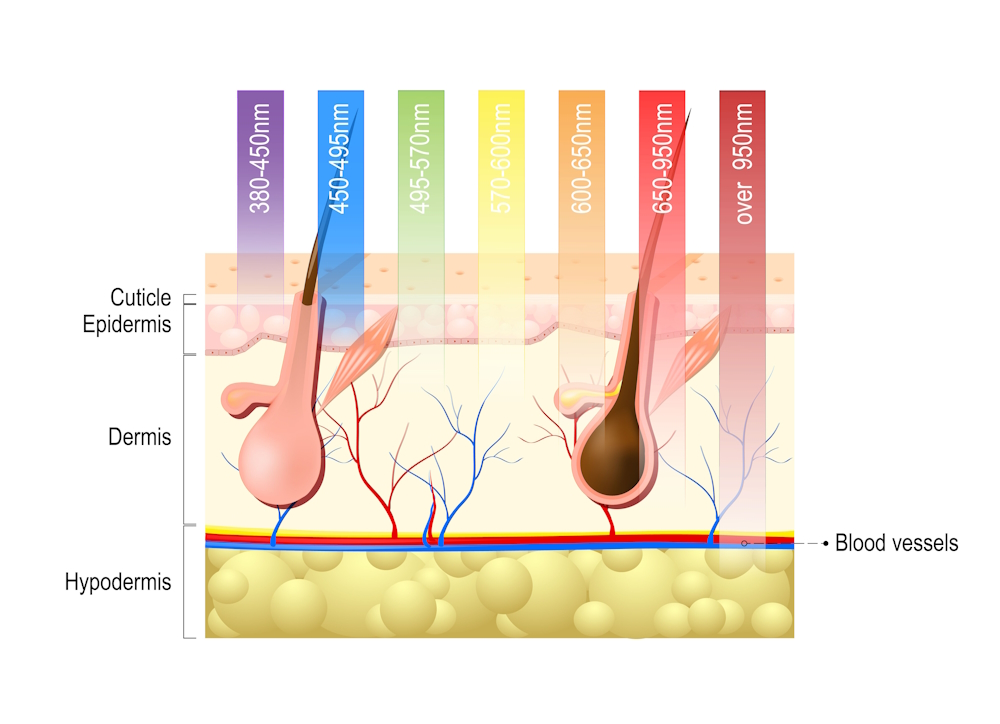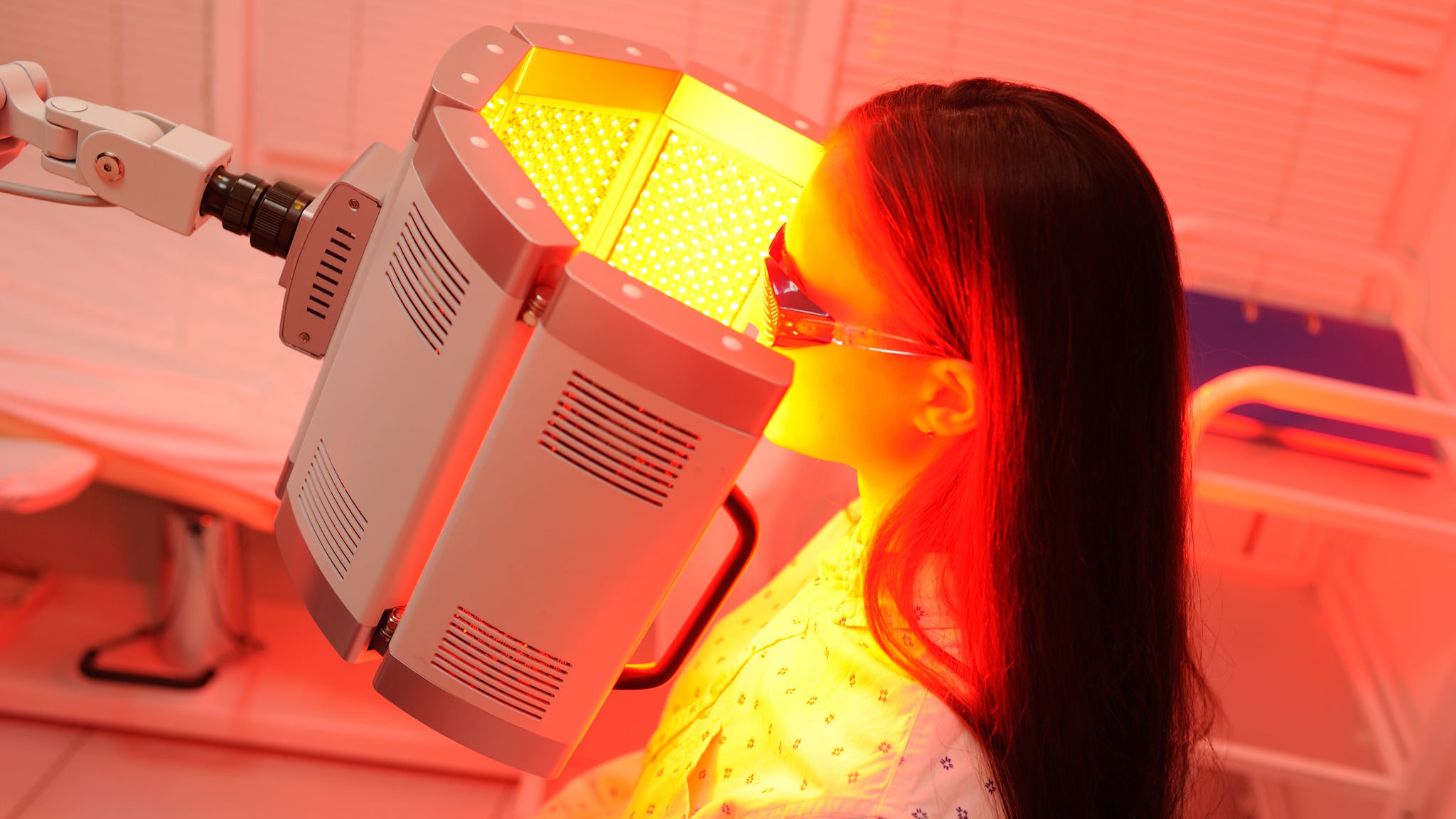A Comprehensive Overview of LED Light Therapy
- 28/09/2023
- Resources
- Dr. Deepali Kapahi
Introduction
LED light therapy, LED photo modulation, photodynamic light therapy (PDT) – or just simply light therapy, is a non-invasive and increasingly popular hair and skincare treatment that uses specific wavelengths of light to stimulate various cellular processes in the body. This therapeutic approach uses light to promote healing, skin and hair rejuvenation, and the management of various skin conditions. LED light therapy is a versatile and safe option, often employed in dermatology and aesthetic clinics.
The concept behind LED light therapy is rooted in the understanding that different colours of light can penetrate the skin at varying depths, interacting with cells and tissues to trigger specific biological responses. These responses can include enhanced collagen production, reduction in inflammation and improved circulation, among others. Depending on the chosen light wavelength (colour), LED therapy can serve various purposes, from minimizing the appearance of fine lines and wrinkles to treating acne, improving skin tone, promoting wound healing, and alleviating pain – and much more.
LED light therapy sessions are typically quick and painless, no longer than 20 minutes per session, involving the exposure of the skin to specific wavelengths of light over the course of multiple sessions, ideally between 24 to 48 sessions over the course of 4 months.

Diagram showing how varying wavelengths (colours) of light penetrate the skin.
Benefits of LED Light Therapy
LED treatments do not contain ultraviolet (UV) rays so does not cause sunburns or cause skin cancers and is not a laser. In fact, red light therapy (RLT) is used to treat damage from the sun and help support wound healing.
Acne Control & Minimized Pore Size
Blue light is often used to treat acne and reduce pore size. Studies show that blue light can kill the bacteria responsible for acne and can also ease how much your oil glands make. This stops the hair follicle from becoming clogged and causing acne. Red light is also typically used in combination with blue light to help ease inflammation and redness, particularly after other skin treatments.
Aging & Skin Rejuvenation
Red light stimulates skin cells called fibroblasts. Fibroblasts help make collagen, which are important parts of skin recovery. Some studies have found that red LED light therapy tightens skin, reduces wrinkles and fine lines, and makes skin smoother and softer.
Photodynamic therapy with 5-aminolevulinic acid (5-ALA) and LED light also ease fine lines and makes the skin softer.
Wound healing
Red LED light stimulates collagen and enhances blood flow which is important for healing wounds. People who have had surgery for skin resurfacing have also had red LED light therapy after the procedure. Studies have found that this form of light therapy lowers redness, swelling, and bruising, and speeds up the healing process.
Pain Relief
LED therapy can help alleviate pain and discomfort associated with various conditions, such as arthritis, muscle soreness, and joint pain. It does this by reducing inflammation and promoting tissue repair.
Hair loss
Red LED light therapy can help stimulate hair follicles promoting hair growth for those with specific hair conditions such as androgenetic alopecia known as male or female pattern hair loss.
Reduced Pigmentation & Red Spots
Blue light can target excess melanin in the skin, helping to reduce the appearance of hyperpigmentation, age spots, and uneven skin tone. Green light can also be used to address redness and vascular issues caused by conditions such as rosacea or broken capillaries, especially when combined with red light therapy.
Psoriasis
Red and near-infrared LED light therapy can help lower redness and inflammation in psoriasis. One study showed that these light therapies also lowered psoriasis pimples and plaques, or red, itchy, scaly sores.
Reduced Inflammation
LED therapy can reduce inflammation in the skin and underlying tissues, which can be beneficial for conditions like rosacea or sunburn.
Improved Athletic Performance
The higher the intensity of the red light emitted, the stronger the muscle contraction, and the more intense the athlete’s performance will be. This is because RLT reduces oxidative stress and increases production of adenosine triphosphate (ATP). Cells become energised, leading to increased cell proliferation and increased tissue oxygenation. One study showed that groups receiving red light therapy treatments showed gains in muscle strength as well as fatigue resistance.

Risks of LED Light Therapy
LED therapy is generally safe for all skin types and tones, and it does not carry the risk of hyperpigmentation or scarring associated with some other skin treatments. LED light therapy is safe when it’s used alone without sensitizing medications or creams. LED lights don’t damage the skin or skin tissues.
LED light therapies might in fact be a better choice compared to other more invasive options, like lasers, because they generally have fewer side effects. They can cause mild reactions though, including:
- Redness
- Swelling
- Itching
- Dryness
This is more likely if you are using photosensitizing medications and can be managed with proper after care.
Research Studies
All statements made in this article are supported by reputable research and multiple studies over many years. Here are a few of our sources if you’re interested in learning the science behind these claims and how the research was performed.
Phototherapy with Light Emitting Diodes
https://www.ncbi.nlm.nih.gov/pmc/articles/PMC5843358/
“Using LEDs with frequencies of 415nm (blue), 633nm (red), and 830nm (infrared), this device has demonstrated significant results for the treatment of medical conditions, including mild-to-moderate acne vulgaris, wound healing, psoriasis, squamous cell carcinoma in situ (Bowen’s disease), basal cell carcinoma, actinic keratosis, and cosmetic applications. Although photodynamic therapy with the photosensitizer 5-aminolevulinic acid might cause stinging and burning, phototherapy is free of adverse events. We determined that phototherapy using LEDs is beneficial for a range of medical and aesthetic conditions encountered in the dermatology practice. This treatment displays an excellent safety profile.”
Photodynamic Therapy with 5-aminolevulinic Acid 10% Gel and Red Light for the Treatment of Actinic Keratosis, Non-melanoma Skin Cancers, and Acne: Current Evidence and Best Practices
https://jcadonline.com/photodynamic-therapy-with-5-aminolevulinic-acid-acne-actinic-keratosis-nonmelanoma/
“Photodynamic therapy (PDT) can be an effective treatment for actinic keratosis (AK) as well as selected non-melanoma skin cancers (NMSCs), such as Bowen’s disease and superficial basal cell carcinoma. PDT has also demonstrated effectiveness in the management of acne vulgaris. Results from controlled clinical trials have shown the safety and efficacy of PDT for these conditions with the use of different photosensitizers and a wide range of light sources.”
Comparison of 5-aminolevulinic acid photodynamic therapy and red light for treatment of photoaging
https://www.sciencedirect.com/science/article/abs/pii/S1572100014000143
“After ALA-PDT or red light illumination, the appearance of photoaging lesions improved, SC hydration increased and TEWL decreased. These changes in the ALA-PDT group were more obvious than those in the red light group. … The ALA-PDT procedure was well tolerated and side effects were minimal. Dermoscopy examination showed marked improvements in fine wrinkling, hyperpigmentation and sallowness in both groups but ALA-PDT was more effective”.
Light as Therapy for Sleep Disorders and Depression
https://www.ncbi.nlm.nih.gov/pmc/articles/PMC3839957/
“High light levels of bluish white light (at least 1,000 lux at the cornea) during morning hours should be considered as a possible therapy for selected older persons with sleep problems and/or depressive symptoms.”
The Science of Serotonin: Red Light Therapy and the Pineal Gland Connection
https://global.rougecare.ca/blogs/rouge-red-light-therapy-blog/the-science-of-serotonin-red-light-therapy-and-the-pineal-gland-connection
“As cells age, they become less efficient at repairing and rejuvenating themselves. Red light therapy can help to boost the production of new cells. With that said, studies have suggested that red light therapy can support the health of the pineal gland by increasing melatonin production, regulating the circadian rhythm, and improving sleep quality. This can be achieved by applying red light therapy to the forehead and scalp.”
Red light-emitting diode irradiation regulates oxidative stress and inflammation through SPHK1/NF-κB activation in human keratinocytes
https://www.sciencedirect.com/science/article/pii/S1011134418301556
“In recent years, the biological effects of visible light have been exploited in dermatological therapy. LEDI is a widely used therapeutic modality that acts through the regulation of cell. LEDI can exert biological effects at specific wavelengths, and studies have suggested that red LED radiation (620–770 nm) can penetrate deeper into the soft tissue than other wavelengths, which is important for ROS scavenging and anti-inflammatory activity”
LED Low-Level Light Photomodulation for Reversal of Photoaging
https://www.sciencedirect.com/science/article/abs/pii/B9780815515722500178
“LED arrays using LILT for photomodulation are useful for collagen stimulation, textural smoothing, and reduction of inflammation. Pilot wound-healing studies show slightly accelerated wound resolution. Cellular rescue from UV damage and other toxic insults has been shown in small studies. Our combined multiyear experience and clinical observations confirm that combinations of thermal nonablative photorejuvenation and nonthermal LED photomodulation have a synergistic effect”
Clinical experience with light-emitting diode (LED) photomodulation
https://pubmed.ncbi.nlm.nih.gov/16176771/
“Conclusion: LED photomodulation reverses signs of photoaging using a new nonthermal mechanism. The anti-inflammatory component of LED in combination with the cell regulatory component helps improve the outcome of other thermal-based rejuvenation treatments.”
